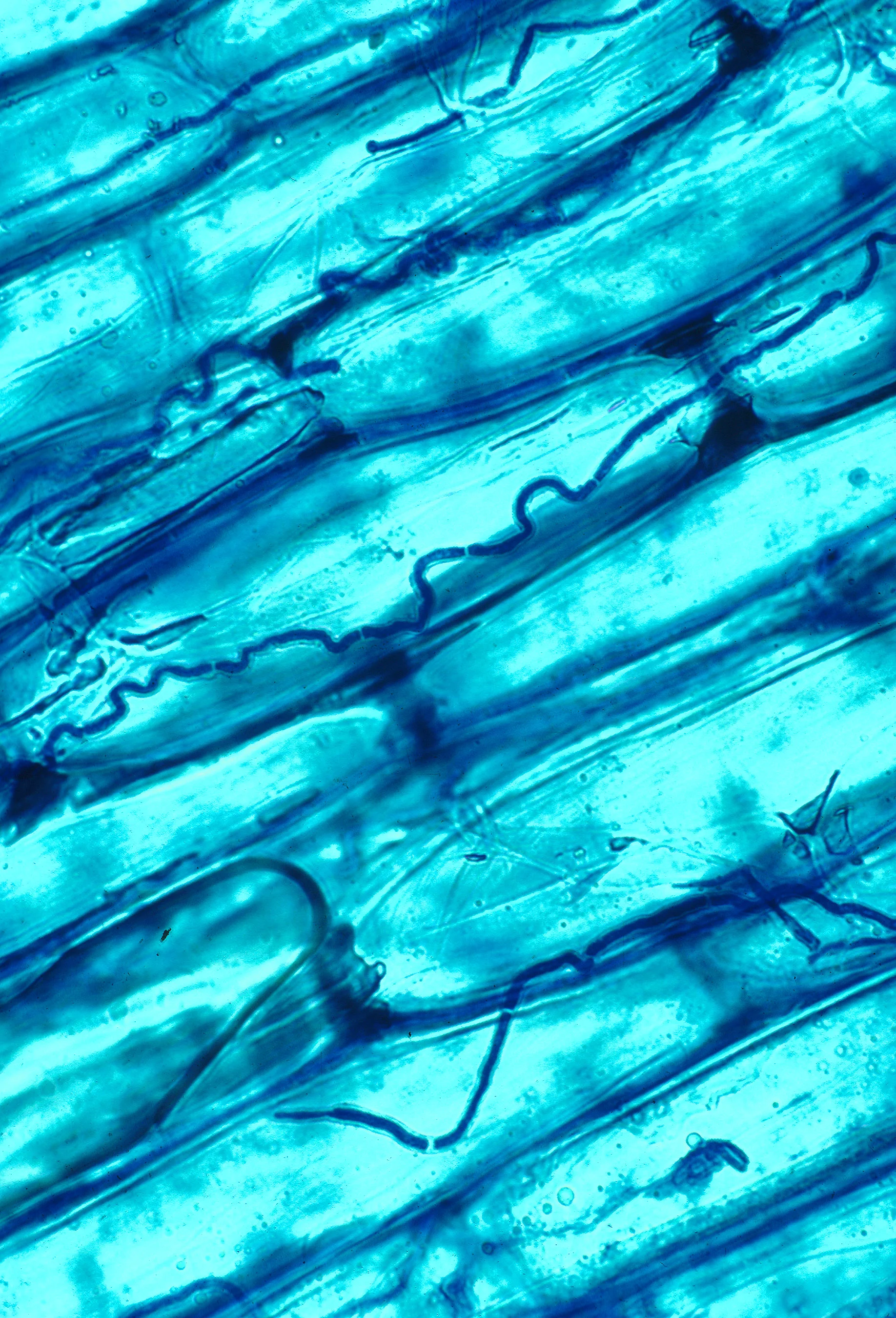Endophytic fungi living in the cells of a grass leaf. Photo by Nick Hill (Public Domain)
Talk about plants long enough and fungi eventually make their way into the conversation. These two walks of life are inextricably linked and probably have been since the earliest days. At this point we are well aware of beneficial fungal partners like mycorrhizae or pathogens like the cedar apple rust. Another type of relationship we are only starting to fully appreciate is that of plants and endophytic fungi living in their above ground tissues.
Endophytic fungi have been discovered in many different types of plants, however, it is best studied in grasses. The closer we look at these symbiotic relationships, the more complex the picture becomes. There are many ways in which plants can benefit from the presence of these fungi in their tissues and it appears that some plants even stock their seeds with fungi, which appears to give their offspring a better chance at establishment.
To start, the benefits to the fungi are rather straight forward. They get a relatively safe place to live within the tissues of a plant. They also gain access to all of the carbohydrates the plants produce via photosynthesis. This is not unlike what we see with mycorrhizae. But what about the plants? What could they gain from letting fungi live in and around their cells?
One amazing benefit endophytic fungi offer plants is protection. Fungi are famous for the chemical cocktails they produce and many of these can harm animals. Such benefits vary from plant to plant and fungi to fungi, however, the overall effect is largely the same. Herbivores feeding on plants like grasses that have been infected with endophytic fungi are deterred from doing so either because the fungi make the plant distasteful or downright toxic. It isn't just big herbivores that are deterred either. Evidence has shown that insects are also affected.
There is even some evidence to suggest that these anti-herbivore compounds might have influences farther up the food chain. It usually takes a lot of toxins to bring down a large herbivore, however, some of these toxins have the potential to build up in the tissues of some herbivores and therefore may influence their appeal to predators. Some have hypothesized that the endophytic fungal toxins may make herbivores more susceptible to predators. Perhaps the toxins make the herbivores less cautious or slow them down, making them more likely targets. Certainly more work is needed before anyone can say for sure.
Italian ryegrass (Lolium multiflorum) is one of the most studied grasses that host endophytic fungi. Photo by Matt Lavin licensed under CC BY-SA 2.0
Another amazing example deals with parasitoids like wasps that lay their eggs in other insects. Researchers found that female parasitoid wasps can discriminate between aphids that have been feeding on plants with endophytic fungi and those without endophytic fungi. Wasp larvae developed more slowly and had a shorter lifespan when raised in aphids that have fed on endophytic fungi plants. As such, the distribution of plants with endophytic symbionts may have serious ramifications for parasitoid abundance in any given habitat.
Another benefit these endophytic fungi offer plants is increased photosynthesis. Amazingly, some grasses appear to photosynthesize better with endophytic fungi living in their tissues than plants without fungi. There are many mechanisms by which this may work but to simplify the matter, it appears that by producing defense compounds, endophytic fungi allow the plant to redistribute their metabolic processes towards photosynthesis and growth. In return, the plants produce more carbohydrates that then feed the fungi living in their tissues.
One of the most remarkable aspects about the relationship between endophytic fungi and plants is that the plants can pass these fungi on to their offspring. Fungi are able to infect the tissues of the host plants' seeds and therefore can be carried with the seeds wherever they go. As the seedlings grow, so do the fungi. Some evidence suggests this gives infected seedlings a leg up on the competition. Other studies have not found such pronounced effects.
Still other studies have shown that it may not be fungi in the seeds that make a big difference but rather the fungi present in the decaying tissues of plants growing around them. Endophytic fungi have been shown to produce allelopathic compounds that poison neighboring plants. Areas receiving lots of plant litter containing endophytic fungi produced fewer plants but these plants grew larger than areas without endophytic fungi litter. Perhaps this reduces competition in favor of plant species than can host said endophytes. Again, this has potentially huge ramifications for the diversity and abundance of plant species living in a given area.
We are only beginning to understand the role of endophytic fungi in the lives of plants and the communities they make up. To date, it would appear that endophytic fungi are potentially having huge impacts on ecosystems around the globe. It goes without saying that more research is needed.
Further Reading: [1] [2] [3] [4] [5] [6]

